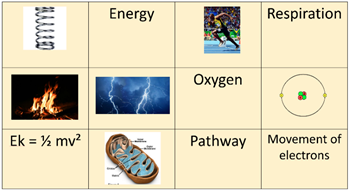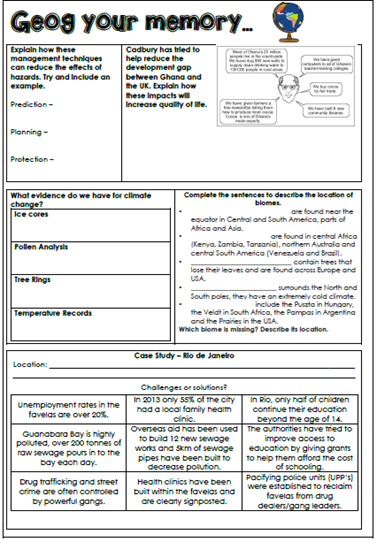November Blog 2022
Retrieval Practice
Retrieval practice is not a new concept in education. Teachers over many years have been working with the technique of getting their students to remember knowledge from past lessons. Here at Crookhorn, we are now looking at best practice and how we can develop our retrieval skills - both as teachers in lessons and students studying independently.
As part of the Developing Blended Learners Programme, we have considered both retrieval and revision and how we can upskill our students to get the most out of their working time. Through discussions, we realised that staff have varied definitions of retrieval and revision, and this was a potential point of confusion for students and parents. We have therefore come up with the following definitions:
Revision:
Going back over taught and learnt content, using previous and new resources, to ensure a secure understanding.
Revision materials:
Concise and accurate documents that contain a clear summary of previously taught content.
Retrieval Practice…
“refers to the act of recalling learned information from memory (with no or little support) and every time that information is retrieved, or an answer generated, it changes that original memory to make it stronger.
The retrieval process cements the information in the long-term memory, which should enable that information to become easier to retrieve in the future.” Kate Jones
- is intended to be low (or no) stakes work
- needs to have appropriate ease and challenge to allow to a high success rate (80%+)
- can be used to close the vocabulary gap and support vocabulary instruction
It is a common misconception that retrieval practice is just about learning facts. Although it is easy to see why this is the case, the process of recalling information regularly supports the development of links within the long-term memory. In turn, this allows students to be able to use this knowledge more effectively when working on new concepts.
We need retrieval to be frequent and ongoing, not just part of revision towards assessments. We need to build retrieval into every lesson as well as independent work. An activity doesn’t need to be long, but the sequence of the activity needs to be carefully planned.
When in class, we need to be explicit with the students that this is a retrieval task. We need to explain to the students the process they are going through and how they can use the same process as part of their independent work.
For the past year, science have been using their ‘Blast from the Past’ sheets which have questions from various time scales in the past.

With this example, the class teacher should be explaining to the students the reasons for revisiting work from a year ago and not just focussing on the last lesson.
The Developing Blended Learners Programme will be working with students to get them to consider their independent learning and revision process, but the more we can support this this in every lesson, the better working practice our students will have.
Seneca is a great way for students to be given short sharp retrieval activities as homework. Taking on board the idea of revisiting over time, a Seneca assignment can be built up of short sections from multiple areas of the Seneca ‘course’. There is no need to complete all of once section of the ‘course’ in one sitting. Careful planning and analysis of the results can ensure coverage of the whole curriculum across time and address weaker areas of knowledge.
The retrieval practice definition shared earlier comes from Kate Jones’ book ‘Retrieval practice: Research and Resources for every classroom’. This, along with book two, is available in the staff library and is an easy read, summarising the work of many practitioners – including Rosenshein and Sherrington on the Principles of instruction. Jones has collected several retrieval techniques and I share a few with you here:
Generic retrieval questions
-
- State 3 facts from last lesson.
- What keywords did you use or learn last lesson?
- Ask your partner 3 questions based on the content covered this term.
- Explain a key concept or idea from last week in your own words.
- Discuss with your partner what we were studying in the lesson last week.
Brain dumps
Simply refers to dumping as much information from the brain about a specific topic
Cops and Robbers
A build on from brain dumps. Once the initial brain dump has been completed, student read other students work and ‘steal’ other information
Retrieval relay race
-
- One question on a page, 4 empty boxes
- Student 1 writes as much as possible in the 1st box
- Paper is passed to student 2 who needs to add ‘more’ information to box 2 – this requires student 2 to read students 1s work before writing their own information
- Pass on to student 3 and 4 accordingly
- Can be done with all students on the same question or a variety of questions in the class
Flashback Friday
As an end of lesson task, students create a list of 10 questions based on the current content (with answers separately if you want). They will return and answer these questions in a future lesson – answering their own questions or a peer’s questions as you see fit.
Retrieval grids
There are many different forms of retrieval grids – this one appealed to me the most.
-
- Create a 3 x 3 grid (or whatever size you want)
- Add a question / fact / keyword etc in each box
- In lesson 1, student complete 1 box of their choice – they will opt for the one they know the best
- Lesson 2 a second box is completed and so on.
‘Apart from the initial lesson, the students will know what they will need to retrieve next lesson, and they may decide in advance which they wish to focus on for the next lesson. The fact that they were deciding to act on that in advance to be prepared in the lesson is brilliant and exactly what they should be doing. Kate Jones
Retrieval at Crookhorn
SCIENCE
Following the memory pedagogy training at the start of November, Sean has been working on a couple of ideas, one of which he shares here:
Thinking inside the box!
Make as many links as you can on your white board between these images.

The purpose of these activities are twofold
a) retrieval opportunity
b) allow students to form their own dual coding - Also allowing you to see when they are unable to do this and therefore address any misconceptions.
 GEOGRAPHY
GEOGRAPHY
Having considered the Retrieval Grids idea from Kate Jones, Barbara has amended the process of her GYM sheets.
Geography now complete these more often as their Do Now task, one box at a time.
Hopefully the students will begin to consider a little revision between lessons as they know what they need to work on in the next lesson.
We’ll be able to share the update on the developed use of these sheets in due course.
We know there is good practice going on around the College and we would like to showcase more. Please can you email AJB with examples from your teaching by the end of term.
